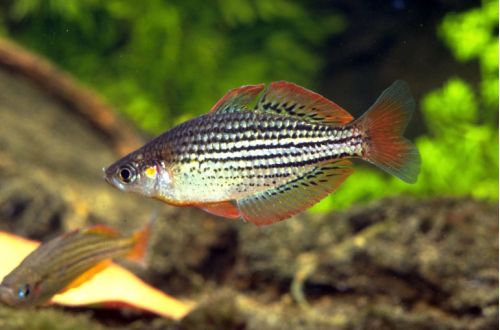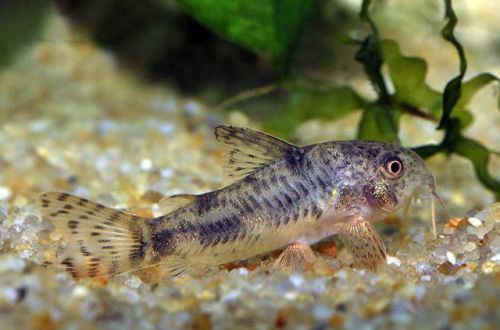
Rainbow fish
Rainbow fish, McCulloch’s Rainbow Melanothenia or Dwarf Rainbowfish, scientific name Melanotaenia maccullochi, belongs to the Melanotaeniidae family. Relatively small fish in comparison with relatives. It is distinguished by a peaceful disposition, ease of maintenance and breeding. It pairs well with other species, making it a good candidate for the general freshwater aquarium.

Contents
Habitat
They originate from Papua New Guinea and Australia. They are found in various biotopes from muddy swampy reservoirs to rivers and lakes with crystal clear water. Fish prefer to stay in places with dense vegetation, near flooded snags, flooded trees.
Brief information:
- The volume of the aquarium – from 60 liters.
- Temperature – 20-30°C
- Value pH — 5.5–8.0
- Water hardness – medium to hard (8-15 dGH)
- Substrate type – any
- Lighting – subdued / moderate
- Brackish water – no
- Water movement is weak
- The size of the fish is up to 7 cm.
- Food – any food
- Temperament – peaceful active
- Keeping a flock of at least 6-8 individuals
Description
Adult individuals reach a length of up to 7 cm. The color is silvery, a characteristic feature of the body pattern is the presence of dark horizontal stripes. There are slight color differences between populations from different regions, some have red fins, others yellow. Females are larger than males, but less colorful.
Food
An unpretentious and omnivorous species, accepts dry, frozen and meat feed. The latter are recommended to be served regularly, at least once a week. This contributes to an increase in the general tone of the fish and the manifestation of a better color.
Maintenance and care, decoration of the aquarium
A group of 6-7 fish will need a tank of at least 60 liters. The design is arbitrary, provided that areas with dense vegetation and free areas for swimming are provided. Maintaining high water quality is critical to keeping Rainbowfish. For these purposes, you should purchase an effective filtration system and weekly replace part of the water (15–20% of the volume) with fresh water. When choosing a filter, give preference to those models that do not cause excessive movement of water in the aquarium, since this type is not adapted to strong currents.
Otherwise, the fish are very unpretentious, they feel great in a wide range of hydrochemical parameters and temperatures.
Behavior and Compatibility
The Dwarf Rainbow has a peaceful and calm disposition, perfectly compatible with other species of comparable size and temperament. The content is flocking, at least 6–8 individuals of both sexes.
Breeding / breeding
Breeding in a home aquarium does not cause much trouble, however, raising fry will not be so easy. Favorable conditions for the onset of the mating season are: slightly alkaline water (pH 7.5) of medium hardness, temperature in the range of 26–29 ° C, regular feeding with high-quality feed. In the design, it is recommended to use clusters of undersized small-leaved plants or mosses, among which the female will lay eggs.
Spawning lasts about 2 weeks, the male can fertilize the clutches of several females at once. Parental instincts are not developed, but, as a rule, adult fish do not pose a threat to eggs and fry, which cannot be said about other aquarium neighbors. To protect future offspring, they are placed in a separate tank with identical water conditions, equipped with a simple airlift filter with a sponge, a lamp and a heater. Live or artificial plants are welcome.
The incubation period lasts 7-12 days. In the first days of life, the fry will feed on the remains of the egg sac, then it is necessary to feed microfeed, for example, ciliates. As young fish mature, they can switch to brine shrimp nauplii and other appropriately sized foods. It is worth remembering that most of the time they swim near the surface, so sinking food is unusable. They simply will not be eaten and will only become a source of water pollution.
Fish diseases
Health problems arise only in case of injuries or when kept in unsuitable conditions, which depresses the immune system and, as a result, provokes the occurrence of any disease. In the event of the appearance of the first symptoms, first of all, it is necessary to check the water for the excess of certain indicators or the presence of dangerous concentrations of toxic substances (nitrites, nitrates, ammonium, etc.). If deviations are found, bring all values back to normal and only then proceed with treatment. Read more about symptoms and treatments in the Aquarium Fish Diseases section.





